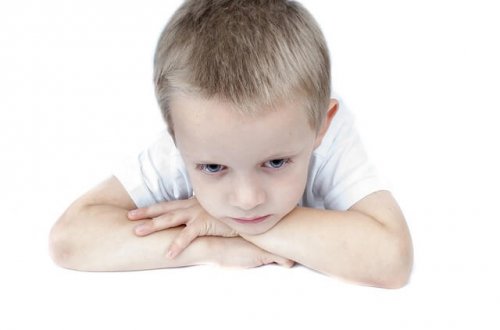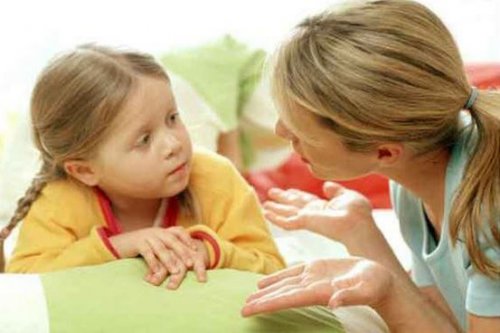Children From 3 to 6 Years Old Who Exclude Other Children, What do Do?

No matter how old you are, when a child feels left out, it’s a horrible feeling that will mark them for a long time if adults don’t know how to act in time. In preschools, children from 3 to 6 years old start to have bullying behaviors and it’s crucial that adults understand this behavior to know how to deal with it. Is it a normal early childhood behavior for little ones to exclude other children, or should something be done about it?
It’s common for children between 3 and 6 years old to exclude other children while playing. It can even be a normal response to the social problems that young children encounter. But it’s the role of the adult to teach the necessary social skills so that they can behave well both with themselves and with others.
Why do children ages 3 to 6 exclude other children?
Children at this age can exclude other children for many reasons, but there are some situations that can be commonly seen in playgrounds, classrooms, and anywhere where children of the same ages are interacting. Some reasons may include the following:
- Because they feel threatened or because they think they themselves might be excluded.
- So that their play isn’t distorted by the arrival of another child.
- To protect the friendship from possible “intruders”.
- To be in control of the game, be the leader, and make decisions about what will happen in the game.
- To keep others from breaking “your social rules” in the game.

How parents react to this fact
There are many parents who think that this is simply a phase and that it will pass, but the reality is that adults should guide children so that they know which behaviors are appropriate and which aren’t when it comes to interacting with their peers.
Adults, when they distract the child who’s experiencing exclusion and help them find other playmates, only show the excluder that their behavior is acceptable and neither party will be able to learn an appropriate way to handle this type of situation.
There’s a school with a rule that goes like this, “You can’t say you can’t play.” It’s a classroom rule that exists so that there’s no exclusion. However, children manage to get around the rules without adults noticing, so it could end up only aggravating the situation by giving more weight to the issue and implying that there are “excluders” and “excludeds”.
There are adults who think that children will learn on their own to handle these situations, but nothing could be further from the truth. Preschool children need adult guidance to be able to practice social skills correctly. Without adult help, it’s difficult for young children to learn to resolve conflicts successfully.
How adults should respond

The appropriate response will depend on the underlying reason for the exclusionary behavior. It’s important to ask the excluder in a non-punitive and non-judgmental way why they don’t want to play with the excluded child. You can say things like, “It sounds like you don’t want to play with M. I’m curious why you can’t play together. If you tell me what’s going on, I can help to make sure this doesn’t happen anymore.” When the reason for the exclusion is clear, then you need to find a solution that balances the needs of both the excluder and the child who has been excluded.
Adults need to successfully guide children and teach them social skills that help them to empathize with others and above all, to begin to express their emotions assertively. The child who’s being excluded will need social skills to learn to relate to others and to be able to succeed in the relationship with their peers.
No matter what situation the children are in, the adult should never look the other way if there’s a moment where one child excludes another. They’ll always need the right guidance and direction to be able to act correctly.
No matter how old you are, when a child feels left out, it’s a horrible feeling that will mark them for a long time if adults don’t know how to act in time. In preschools, children from 3 to 6 years old start to have bullying behaviors and it’s crucial that adults understand this behavior to know how to deal with it. Is it a normal early childhood behavior for little ones to exclude other children, or should something be done about it?
It’s common for children between 3 and 6 years old to exclude other children while playing. It can even be a normal response to the social problems that young children encounter. But it’s the role of the adult to teach the necessary social skills so that they can behave well both with themselves and with others.
Why do children ages 3 to 6 exclude other children?
Children at this age can exclude other children for many reasons, but there are some situations that can be commonly seen in playgrounds, classrooms, and anywhere where children of the same ages are interacting. Some reasons may include the following:
- Because they feel threatened or because they think they themselves might be excluded.
- So that their play isn’t distorted by the arrival of another child.
- To protect the friendship from possible “intruders”.
- To be in control of the game, be the leader, and make decisions about what will happen in the game.
- To keep others from breaking “your social rules” in the game.

How parents react to this fact
There are many parents who think that this is simply a phase and that it will pass, but the reality is that adults should guide children so that they know which behaviors are appropriate and which aren’t when it comes to interacting with their peers.
Adults, when they distract the child who’s experiencing exclusion and help them find other playmates, only show the excluder that their behavior is acceptable and neither party will be able to learn an appropriate way to handle this type of situation.
There’s a school with a rule that goes like this, “You can’t say you can’t play.” It’s a classroom rule that exists so that there’s no exclusion. However, children manage to get around the rules without adults noticing, so it could end up only aggravating the situation by giving more weight to the issue and implying that there are “excluders” and “excludeds”.
There are adults who think that children will learn on their own to handle these situations, but nothing could be further from the truth. Preschool children need adult guidance to be able to practice social skills correctly. Without adult help, it’s difficult for young children to learn to resolve conflicts successfully.
How adults should respond

The appropriate response will depend on the underlying reason for the exclusionary behavior. It’s important to ask the excluder in a non-punitive and non-judgmental way why they don’t want to play with the excluded child. You can say things like, “It sounds like you don’t want to play with M. I’m curious why you can’t play together. If you tell me what’s going on, I can help to make sure this doesn’t happen anymore.” When the reason for the exclusion is clear, then you need to find a solution that balances the needs of both the excluder and the child who has been excluded.
Adults need to successfully guide children and teach them social skills that help them to empathize with others and above all, to begin to express their emotions assertively. The child who’s being excluded will need social skills to learn to relate to others and to be able to succeed in the relationship with their peers.
No matter what situation the children are in, the adult should never look the other way if there’s a moment where one child excludes another. They’ll always need the right guidance and direction to be able to act correctly.
All cited sources were thoroughly reviewed by our team to ensure their quality, reliability, currency, and validity. The bibliography of this article was considered reliable and of academic or scientific accuracy.
- De Miguel, P. (2014). Enseñanza de habilidades de interacción social en niños con riesgo de exclusión. Revista de psicología clínica con niños y adolescentes, 1(1), 17-26. https://dialnet.unirioja.es/servlet/articulo?codigo=4696236
- Chauvie, P. (2015). Empatía: Efectos de los vínculos primarios. Consultado el, 5. https://www.psicologos.org.uy/wp-content/uploads/2018/06/Paola-Lorena-Chauvie-Empatia-Los-efectos-de-los-vinculos-primarios.pdf
This text is provided for informational purposes only and does not replace consultation with a professional. If in doubt, consult your specialist.








